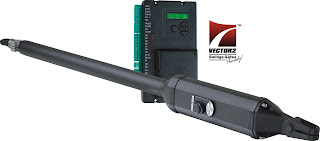The VECTOR2 is one of the easiest-to-install and most user-friendly swing gate operators on the market today. A revolutionary planetary gearbox, DC motor and centrifugal braking system make the VECTOR2 a reliable, robust and versatile gate motor that can be used to automate gates for domestic as well as light-industrial applications. The setup is veritable child’s play, with an LCD interface guiding the user through all the steps via an exceptionally user-friendly wizard.
To summarise, installing and setting up the VECTOR2 is easy as pie, but there are still some things you, the installer can do to ensure the initial and continued reliable operation of your gate motor.
1. What’s your angle?
In all aspects of life, be it in a business sense or when deciding what to cook for dinner, one needs an angle. A strategy, an approach. The same is true when it comes to installing your VECTOR2 operator, but this time we’re talking geometry. Don’t worry, you don’t need to go digging for your old high school maths textbooks, just look to the accompanying installation manual or pocket guide for guidance. The swing angle is important, as this is used to determine the maximum weight that the gate can be for a given operator, be it V400 or V500. The wider the swing angle, the less the load can be. For instance, a gate opening to 120° that is 2.5m high, must not weigh more than 65kg if you wish to automate it with a V400. The VECTOR2 installation manual contains a table denoting the different swing angles and corresponding length and weight.
2. Dimensions
This is a crucial part of the pre-installation process and one that is sadly often overlooked. The function of the A and B values is to serve as guidelines as to the ideal mounting points on the gate and pillar, i.e. the locations that will allow the actuators to operate with a minimum of strain upon the gearbox. The respective values will also depend upon the gate opening angle, the gate size and the stroke length, and is tabulated below.
For gates opening to an angle of 90° or less, the A value is obtained by measuring the distance from the centre of the pillar to the centre of the gate hinge, while the B value is obtained by measuring the distance from the centre of the pillar to the point on the mounting bracket where the actuator is to be mounted. The VECTOR2 installation manual contains tables denoting the various possible A and B dimensions and corresponding swing angles, length, weight, etc.
3. The winds of change
Wind loading refers to the force exercised upon the gate by the wind blowing against it, and is determined by factors such as the coverage of the gate (is it solid or does it have slots?) as well as the length. The A and B values also come into play here, as higher combined values usually result in the operators being able to handle higher wind speeds. Once again, a reference table is available in the manual.
4. Get the cable right!
If the sensor harness isn’t tied off correctly, it can wreak all sorts of havoc. The sensor signal might not be relayed to the encoder reliably and you’ll hear the tell-tale “clack-clack-clack” sound of a failed DOSS. Alternatively, the controller might not even complete the setup if this cable is in distress. Tie the cable off in such a way as to allow for a 350mm loop between the cable exit at the back of the operator and either the mounting bracket or the junction box, to minimise the flexing of the harness.
It is recommended that VECTOR cable be used for all VECTOR2 installations for the following reasons:
· The cable is shielded, reducing the chance of the sensor signal being scrambled if the VECTOR cable is routed in the same conduit as high voltage lines such as electric fence wiring, etc.
· It should make it much easier for the installer to complete an installation since only one cable per actuator needs to be pulled
· The cable is multi-stranded, making it more reliable when terminated on either end
· The cable thicknesses are correct for the DOSS and motor
Follow these few simple guidelines and you’re guaranteed a VECTOR2 that swings gates precisely!






